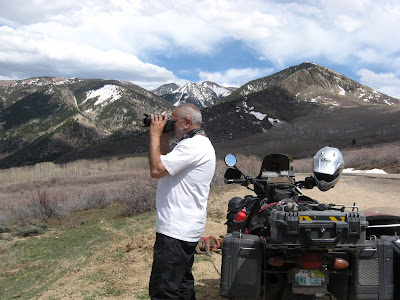There is a very fine landscape and geologic/nature photographer, Ara Gureghian, who with his companion, Spirit - now a gentle Pit Bull rescued by Ara 3-years ago after a life of abuse and about to be put away, are full-time vagabonds. Here's Ara following his snapping some photos.
 And Spirit.
And Spirit.
Check Ara & Spirit's blog site http://theoasisofmysoul.com/ to read about their adventures and see examples of Ara's awesome photography and read of his view of life and experiences. Be sure to peruse the archives section of his blog - you will not be disappointed!! Here's a photo of the master photographer with the volcanic La Sal Mountains behind.

For many years before adopting the RV lifestyle, Ara soloed in a sailboat. He is reported to be an excellent chef/cook and now works occasionally wherever he finds an opportunity to delight appreciative diners.
Ara and Spirit are inseparable, living in a RV Class C portable home and towing a trailer upon which is transported their BMW motorcycle/side car, which they use to see the local sights, etc., just as I do in my Jeep Liberty. In the sidecar rides Spirit, complete with doggels and a helmet.

RV caravanning friends, Landon & Marcella Skinnell and their Beagle, BJ,
 and I had a very good day with Ara and Spirit together in Moab, Utah, riding what is called the La Sal Mountain Loop drive - a 100-mile drive out of Moab, up through red rock/desert conditions,
and I had a very good day with Ara and Spirit together in Moab, Utah, riding what is called the La Sal Mountain Loop drive - a 100-mile drive out of Moab, up through red rock/desert conditions,  to the lava covered flanks of the still snow-covered peaks of the La Sal Mountains. The westward view from along the flanks is out over and down into Canyonlands and Arches National Parks. Here's Ara photoing his BMW which has a snowman on the front of the sidecar.
to the lava covered flanks of the still snow-covered peaks of the La Sal Mountains. The westward view from along the flanks is out over and down into Canyonlands and Arches National Parks. Here's Ara photoing his BMW which has a snowman on the front of the sidecar. 
As one proceeds from south to north up to and after traversing the flank, you enter Castle Valley where the Priest and Rectory/Nuns and Fisher Towers features become so prominent and magnificient.

Each time when visiting this area, I drive the Loop. Passing by the Priest and Rectory/Nuns area, I recall being with my youngest son, Bruce, (me awaiting at the bottom) as he and a climbing buddy summited the Priest. Recently, I received a report of the sucessful summiting of Sister Superior, one of the Rectory/Nuns, by a close friend of Bruce's. This photo includes Ara, Landon and the Priest and Rectory/Nuns. Sister Superior is at the left.












